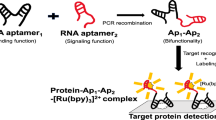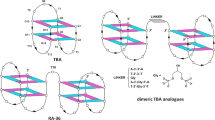Abstract
Using DNA aptamers selectively recognizing anion-binding exosites 1 and 2 of thrombin as a model, it has been demonstrated that their conjugation by a poly-(dT)-linker (ranging from 5 to 65 nucleotides (nt) in length) to produce aptamer heterodimeric constructs results into affinity enhancement. At the linker lengths ranged from 35 to 55 nt the apparent dissociation constants (K appD ) measured using the optical biosensor Biacore-3000 for complexes of thrombin with the heterodimeric constructs reached minimum values (K appD ) = 0.2–0.4 nM), which were approximately 30-fold less than for the complexes with the initial aptamers. A photoaptamer heterodimeric construct was designed connecting photoaptamer and aptamer sequences with the poly-(dT)-linker of 35 nt long. The photoaptamer used could form photo-induced cross-links with the exosite 2 of thrombin and the aptamer could bind to the exosite 1. The (K appD value for the photoaptamer construct was approximately 40-fold less than that for the primary photoaptamer (5.3 and 190 nM, respectively). Upon exposure of the equimolar mixtures of thrombin with the photoaptamer construct to the UV radiation at 308 nm the equal yield of the crosslinked complexes was observed at concentrations, which were lower by two orders of magnitude than in the case of the primary photoaptamer. It was found that concurrently with crosslinking to thrombin a photo-induced inactivation of the photoaptamer occurs presumably due to formation of the intermolecular crosslinking.
Similar content being viewed by others
References
Jayasena, S.D., Clin. Chem., 1999, vol. 45, pp. 1628–1650.
Radko, S.P., Rakhmetova, S.Yu., Bodoev, N.V., and Archakov, A.I., Biomed. Khim., 2007, vol. 53, pp. 5–24.
Mairal, T., Ozalp, V.C., Lozano Sánchez, P., Mir, M., Katakis, I., and O’sullivan, C.K., Anal. Bioanal. Chem., 2008, vol. 390, pp. 989–1007.
Kulbachinskii, A.V., Usp. Biol. Khim., 2006, vol. 46, pp. 193–224.
Golden, M.C., Collins, B.D., Willis, M.C., and Koch, T.H., J. Biotechnol., 2000, vol. 81, pp. 167–178.
Smith, D., Collins, B.D., Heil, J., and Koch, T.H., (2003) Mol. Cell. Proteomics, 2003, vol. 2, pp. 11–18.
Tasset, D.M., Kubik, M.F., and Steiner, W., J. Mol. Biol., 1997, vol. 272, pp. 688–698.
Ruckman, J., Green, L.S., Beeson, J., Waugh, S., Gillette, W.L., Henninger, D.D., Claesson-Welsh, L., and Janjic, N., J. Biol. Chem., 1998, vol. 273, pp. 20556–20567.
Bock, C., Coleman, M., Collins, B., Davis, J., Foulds, G., Gold, L., Greef, C., Heil, J., Heilig, J.S., Hicke, B., Hurst, M.N., Husar, G.M., Miller, D., Ostroff, R., Petach, H., Schneider, D., Vant-Hull, B., Waugh, S., Weiss, A., Wilcox, S.K., and Zichi, D., Proteomics, 2004, vol. 4, pp. 609–618.
Gander, T.R., and Brody, E.N., Expert Rev. Mol. Diagn., 2005, vol. 5, pp. 1–3.
Ivanov, Y.D., Govorun, V.M., Bykov, V.A., and Archakov, A.I., Proteomics, 2006, vol. 6, pp. 1399–1414.
Umehara, T., Fukuda, K., Nishikawa, F., Kohara, M., Hasegawa, T., and Nishikawa, S., J. Biochem. (Tokyo), 2005, vol. 137, pp. 339–347.
Müller, J., Wulffen, B., Pötzsch, B., and Mayer, G., Chembiochem., 2007, vol. 8, pp. 2223–2226.
Kim, Y., Cao, Z., and Tan, W., Pros. Natl. Acad. Sci. USA, 2008, vol. 105, 5664–5669.
Tian, L., and Heyduk, T., Biochemistry, 2009, vol. 48, pp. 264–275.
Bock, L.C., Griffin, L.C., Latham, J.A., Vermass, E.H., and Toole, J.J., Nature, 1992, vol. 355, pp. 564–566.
Macaya, R.F., Waldron, J.A., Beutel, B.A., Gao, H., Joeston, M.E., Yang, M., Patel, R., Bertelsen, A.H., and Cook, A.G., Biochemistry, 1995, vol. 34, pp. 4478–4492.
Koch, T.H., Smith, D., Tabacman, E., and Zichi, D.A., J. Mol. Biol., 2004, vol. 336, pp. 1159–1173.
Zeng, Y. and Wang, Y., Nucleic Acids Res., 2006, vol. 34, pp. 6521–6529.
Author information
Authors and Affiliations
Corresponding author
Additional information
Original Russian Text © S.Yu. Rakhmetova, S.P. Radko, O.V. Gnedenko, N.V. Bodoev, A.S. Ivanov, A.I. Archakov, 2010, published in Biomeditsinskaya Khimiya.
Rights and permissions
About this article
Cite this article
Rakhmetova, S.Y., Radko, S.P., Gnedenko, O.V. et al. Photoaptameric heterodimeric constructs as a new approach to enhance the efficiency of formation of photocrosslinks with a target protein. Biochem. Moscow Suppl. Ser. B 4, 68–74 (2010). https://doi.org/10.1134/S1990750810010099
Received:
Published:
Issue Date:
DOI: https://doi.org/10.1134/S1990750810010099




